Lo Mein Noodles & How to Cook Them
Lo mein noodles are one of the most recognizable types of Chinese noodles in the U.S. Today, we’ll teach you how to cook lo mein noodles properly, so that they’re perfect—not overly starchy, sticky, soggy, dry, or undercooked. We also have a Chinese takeout menu’s worth of lo mein recipes, linked below! Whether you love chicken lo mein, beef lo mein, shrimp lo mein, roast pork lo mein, vegetable lo mein, or a Happy Family Lo Mein with everything in it, we’ve got you covered. Armed with the knowledge of how to prepare lo mein for stir-frying, you’ll be able to execute on any of those dishes with ease! What is Lo Mein? Lo mein is a Chinese noodle made with egg and wheat flour that is first cooked in hot water like pasta, sometimes oiled, and then stir-fried on a hot wok with meat/protein and/or vegetables like carrot, snow peas, bean sprouts, mushrooms, water chestnuts, and green onion/scallions. The noodles get their flavor from a lo mein sauce that includes ingredients like light soy sauce, dark soy sauce, oyster sauce, sesame oil, and a little sugar. It has become a popular mainstay on Chinese takeout menus across the United States. Lo mein as we know it here is a Chinese American dish! Lo mein in Cantonese (lāo miàn in Mandarin – 捞面) translates to “scooped noodles” or “stirred noodles.” It refers to the scooping motion you make when stir-frying the noodles in the wok, which is an important technique for cooking them evenly and ensuring they don’t stick. The beauty of the dish is that you can make it with whatever ingredients you have on hand! Lo mein noodles are nice and chewy, and have a texture different from dried pasta or soup noodles. While you could substitute cooked spaghetti in a lo mein recipe, we highly recommend seeking out the real thing if you have a Chinese grocery store locally. If you’ve ever eaten lo mein in a restaurant, you know their texture and taste are very specific! Challenges When Cooking Lo Mein Noodles I have cooked a lot of lo mein dishes in my days both in a restaurant kitchen and at home. It’s become a dish that I make on autopilot. But after receiving comments and questions from our readers over the years, I’ve seen that many of you are running into issues with cooking lo mein. Many are problems that I’ve never encountered, like sticky, raw, or dry noodles. I realized that I was unconsciously making small automatic adjustments to avoid such problems, and that greater explanation was in order. So let’s set everyone straight and share those tips to avoid kitchen disappointment. Cooked vs. Uncooked Lo Mein Noodles Lo mein noodles can be found in the fresh noodle section of the grocery store, near the fresh white wheat noodles, fresh ramen, fresh Hong-Kong-Style Pan-fried Noodles (aka chow mein noodles), etc. They come cooked and uncooked. This is where a lot of the confusion starts when it comes to preparation. Uncooked lo mein noodles allow you to adjust the texture of the lo mein, since you can cook them al dente and chewier, or for more time to make them softer. Top two packages are uncooked, and bottom package is cooked. You may see them labeled simply, “lo mein noodle,” which is usually a package of raw noodles. If you’re unsure, look at the noodles themselves. Do they look like raw uncooked fresh pasta? Do they have a light dusting of flour still on them? They are raw! Meanwhile, the cooked version may be labeled simply, “cooked noodle,” “oiled noodle,” or “oil noodle.” They have a shiny appearance, as they are indeed covered in a light coating of oil to prevent them from sticking together. Cooked lo mein noodles are more convenient and quick than uncooked noodles, as they don’t need to be boiled before stir-frying or adding them to soup. All you need to do is take them out of the refrigerator and let them sit until they come up to room temperature. As you can see in the photo above, the package tells you to boil the cooked noodles. This is not necessary, which is why we say that package instructions are a starting point rather than gospel! We have instructions for both, but it’s important to check the package to see which type you have first. Note, in addition to stir-frying, you can use these noodles in soups, like Sarah’s Laksa Noodle Soup. What About Dried Lo Mein Noodles? You may also see dried white noodles of different thicknesses labeled “lo mein noodles.” While this may indicate that the noodles are suitable for stir-frying after being boiled, we generally don’t use dried noodles to make lo mein. We find these dried noodles to be closer to regular soup noodles than lo mein noodles. That said, if shelf-stable noodles ordered online are your only option, you can try these. Which brings us to everyone’s favorite topic…substitutions! Is There a Substitute for Lo Mein Noodles? Lo mein noodles are usually available in any Chinese or Asian grocery store, in the refrigerated section where all of the fr
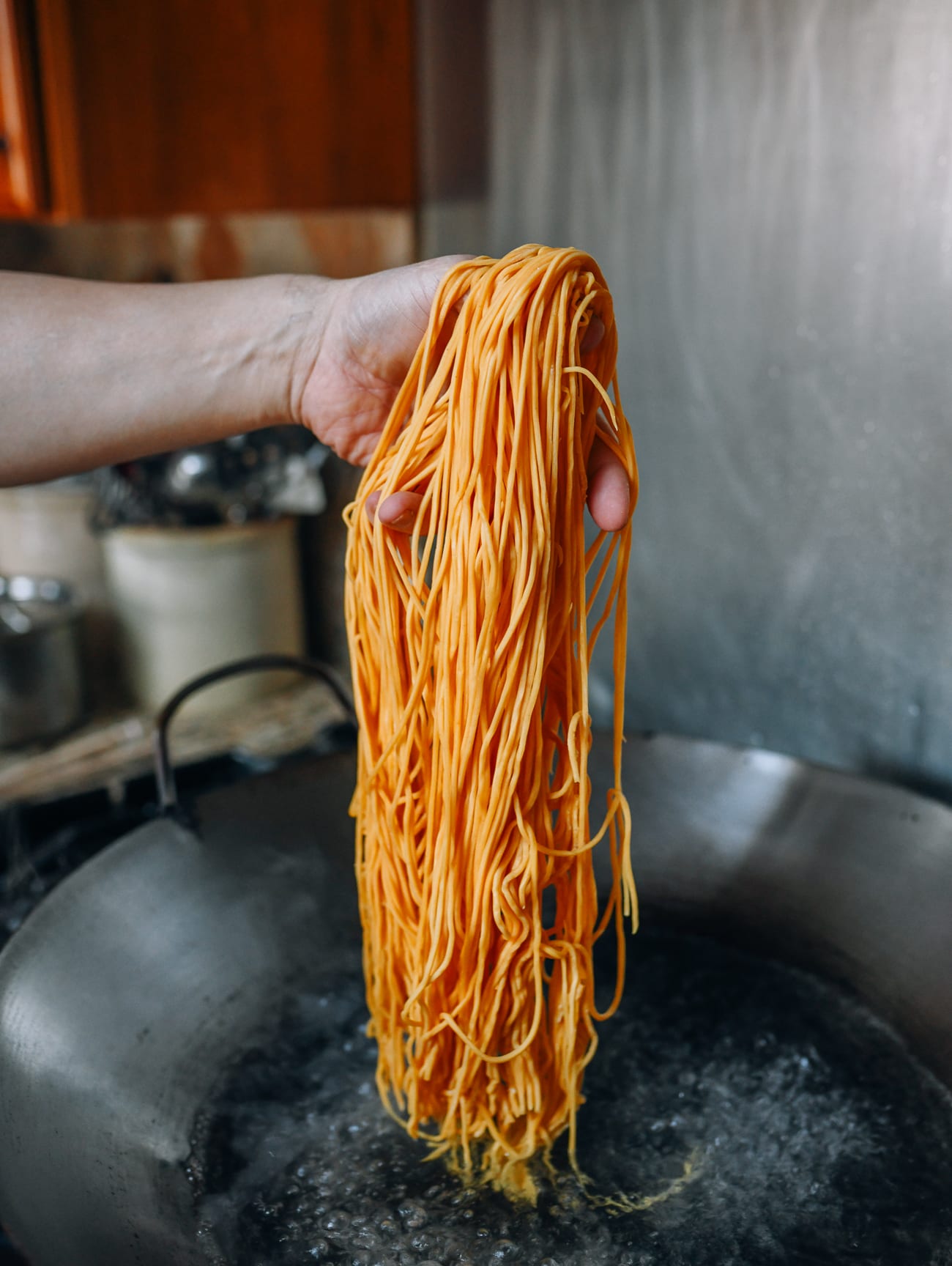
Lo mein noodles are one of the most recognizable types of Chinese noodles in the U.S. Today, we’ll teach you how to cook lo mein noodles properly, so that they’re perfect—not overly starchy, sticky, soggy, dry, or undercooked.
We also have a Chinese takeout menu’s worth of lo mein recipes, linked below! Whether you love chicken lo mein, beef lo mein, shrimp lo mein, roast pork lo mein, vegetable lo mein, or a Happy Family Lo Mein with everything in it, we’ve got you covered.
Armed with the knowledge of how to prepare lo mein for stir-frying, you’ll be able to execute on any of those dishes with ease!
What is Lo Mein?
Lo mein is a Chinese noodle made with egg and wheat flour that is first cooked in hot water like pasta, sometimes oiled, and then stir-fried on a hot wok with meat/protein and/or vegetables like carrot, snow peas, bean sprouts, mushrooms, water chestnuts, and green onion/scallions.
The noodles get their flavor from a lo mein sauce that includes ingredients like light soy sauce, dark soy sauce, oyster sauce, sesame oil, and a little sugar.
It has become a popular mainstay on Chinese takeout menus across the United States. Lo mein as we know it here is a Chinese American dish!
Lo mein in Cantonese (lāo miàn in Mandarin – 捞面) translates to “scooped noodles” or “stirred noodles.” It refers to the scooping motion you make when stir-frying the noodles in the wok, which is an important technique for cooking them evenly and ensuring they don’t stick. The beauty of the dish is that you can make it with whatever ingredients you have on hand!
Lo mein noodles are nice and chewy, and have a texture different from dried pasta or soup noodles.
While you could substitute cooked spaghetti in a lo mein recipe, we highly recommend seeking out the real thing if you have a Chinese grocery store locally. If you’ve ever eaten lo mein in a restaurant, you know their texture and taste are very specific!
Challenges When Cooking Lo Mein Noodles
I have cooked a lot of lo mein dishes in my days both in a restaurant kitchen and at home. It’s become a dish that I make on autopilot.
But after receiving comments and questions from our readers over the years, I’ve seen that many of you are running into issues with cooking lo mein. Many are problems that I’ve never encountered, like sticky, raw, or dry noodles.
I realized that I was unconsciously making small automatic adjustments to avoid such problems, and that greater explanation was in order. So let’s set everyone straight and share those tips to avoid kitchen disappointment.
Cooked vs. Uncooked Lo Mein Noodles
Lo mein noodles can be found in the fresh noodle section of the grocery store, near the fresh white wheat noodles, fresh ramen, fresh Hong-Kong-Style Pan-fried Noodles (aka chow mein noodles), etc.
They come cooked and uncooked. This is where a lot of the confusion starts when it comes to preparation. Uncooked lo mein noodles allow you to adjust the texture of the lo mein, since you can cook them al dente and chewier, or for more time to make them softer.
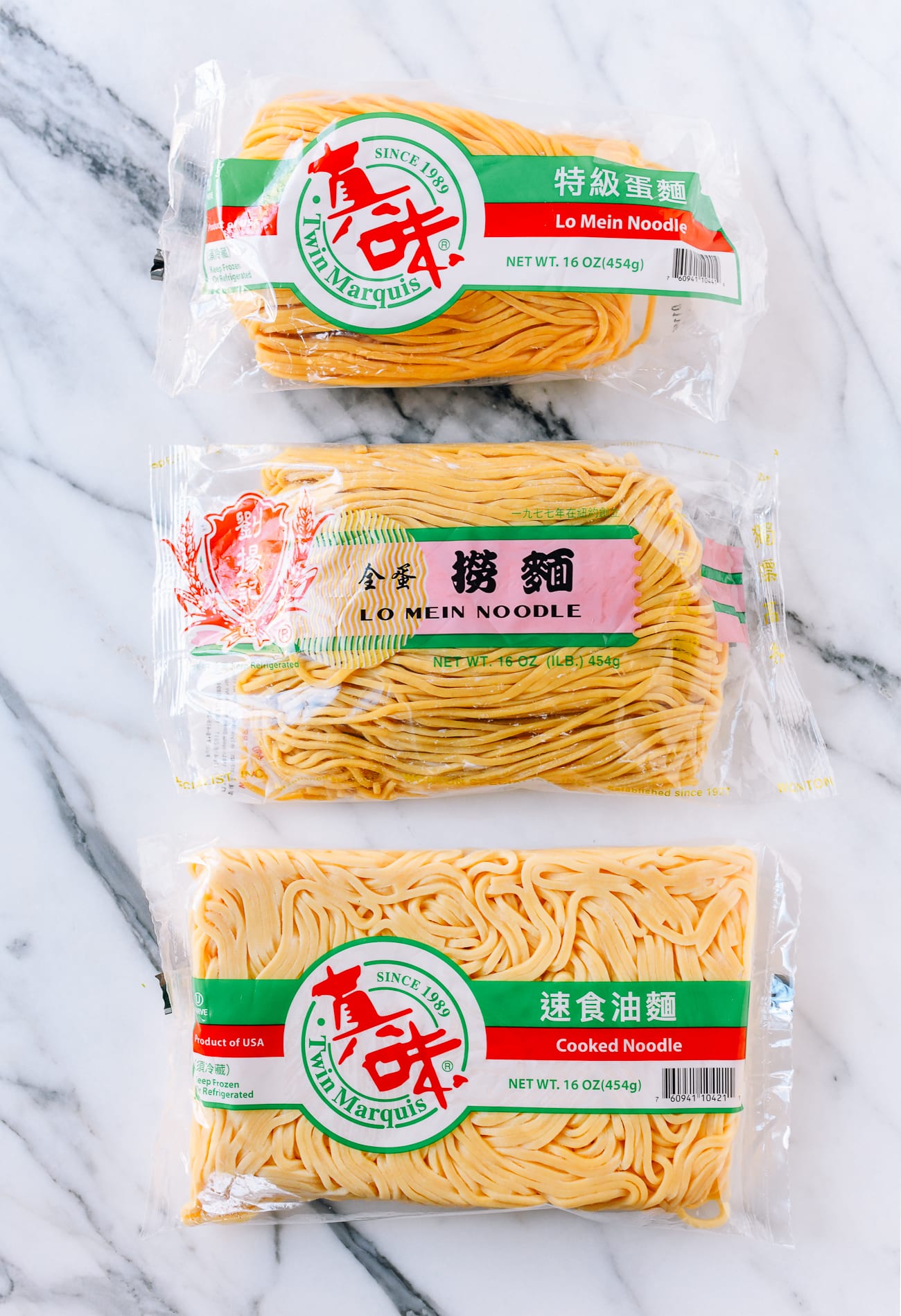
You may see them labeled simply, “lo mein noodle,” which is usually a package of raw noodles.
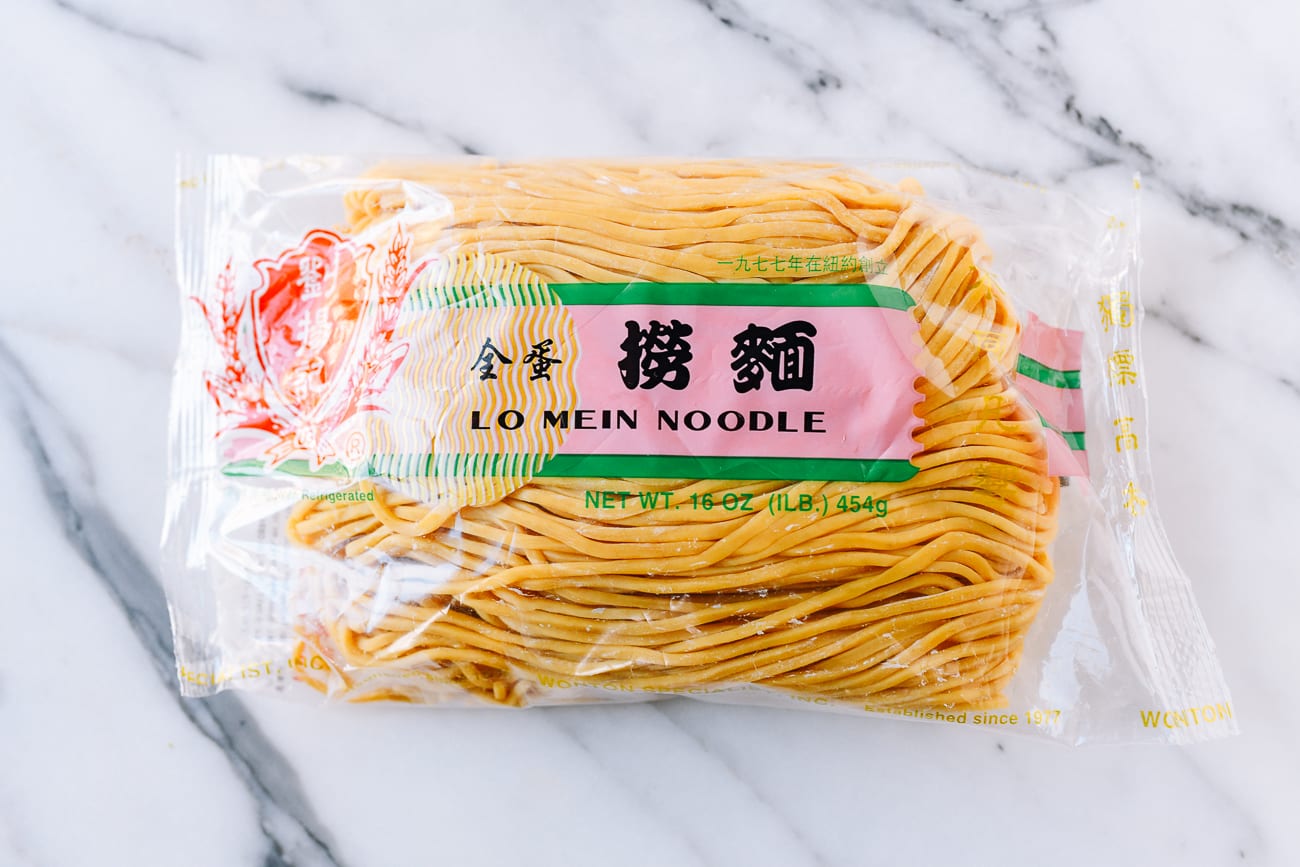
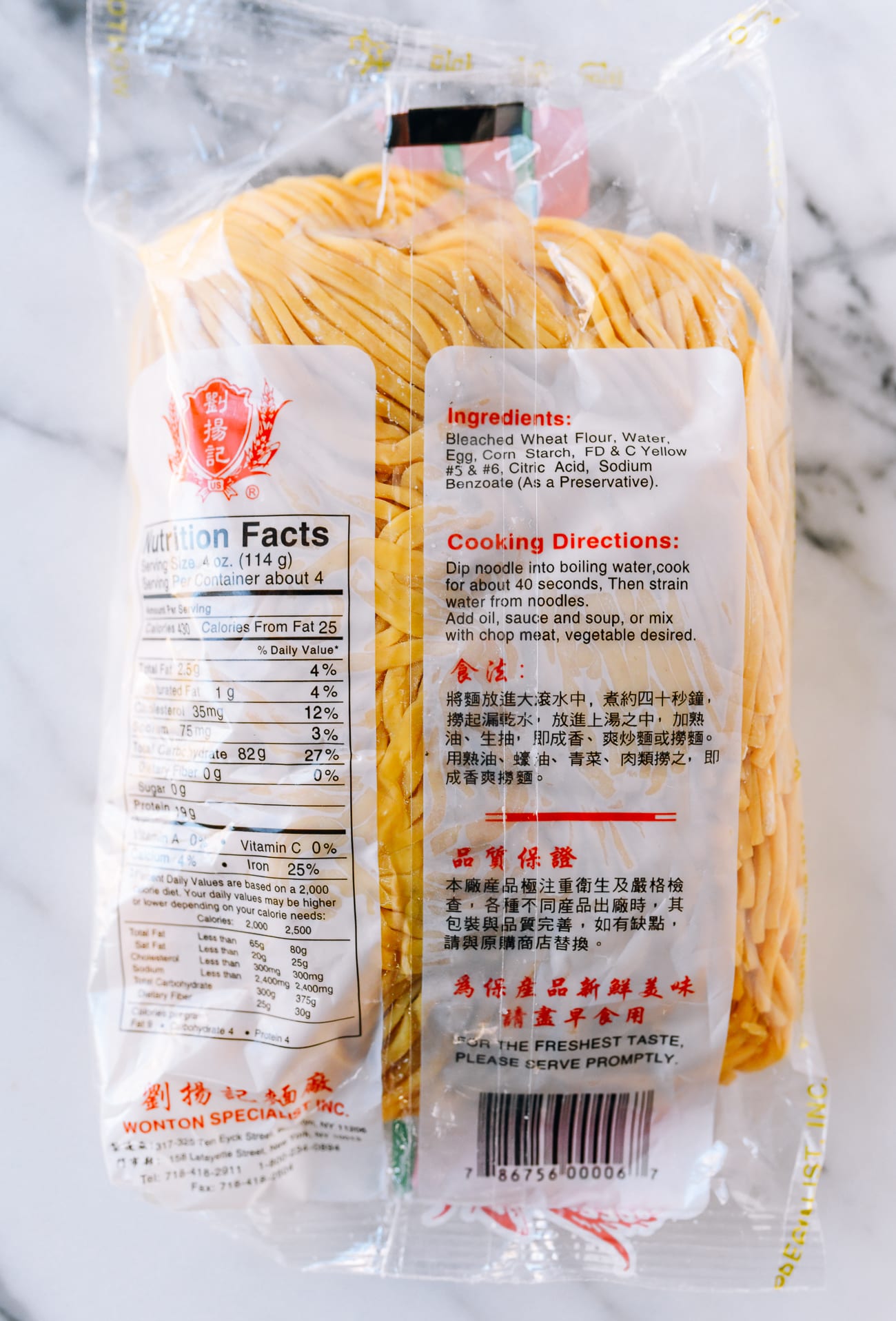
If you’re unsure, look at the noodles themselves. Do they look like raw uncooked fresh pasta? Do they have a light dusting of flour still on them? They are raw!
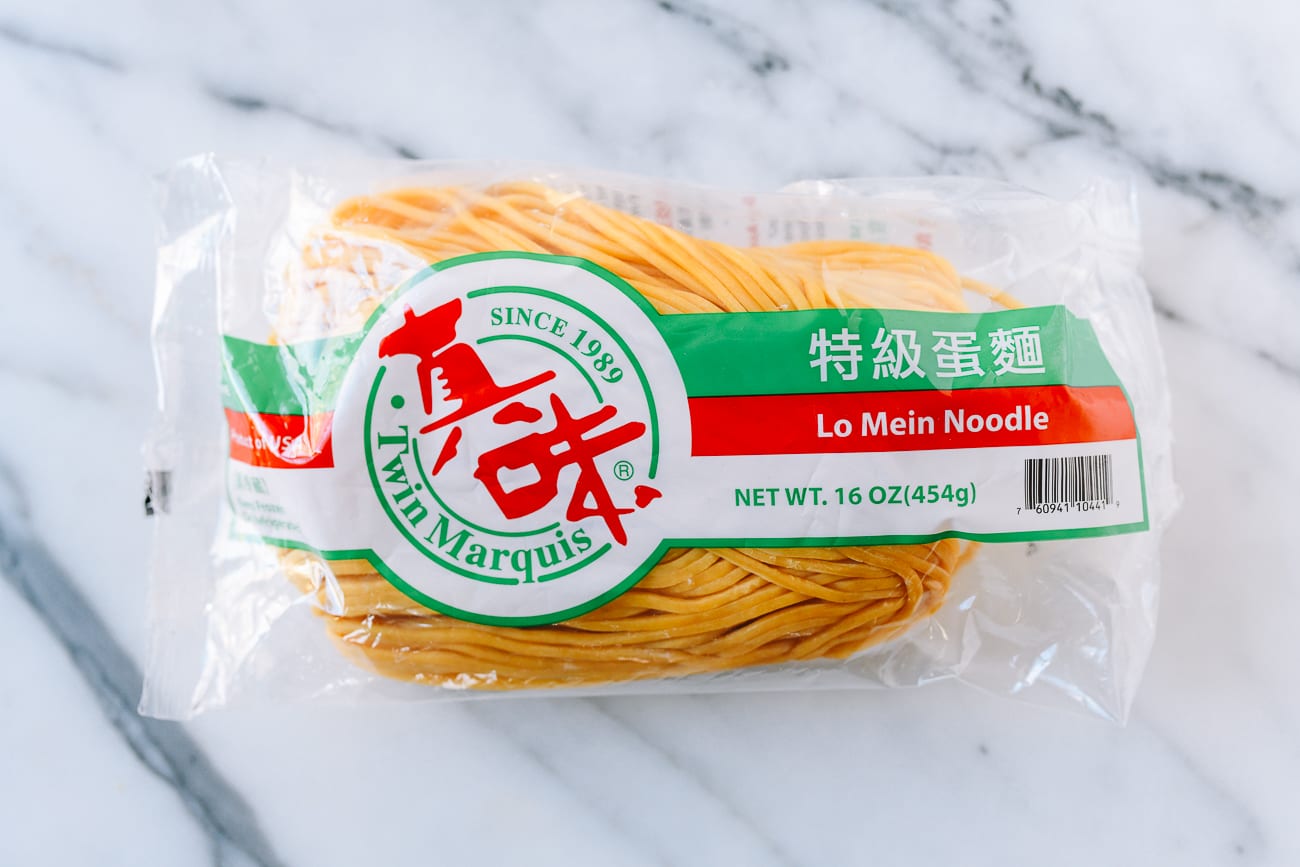
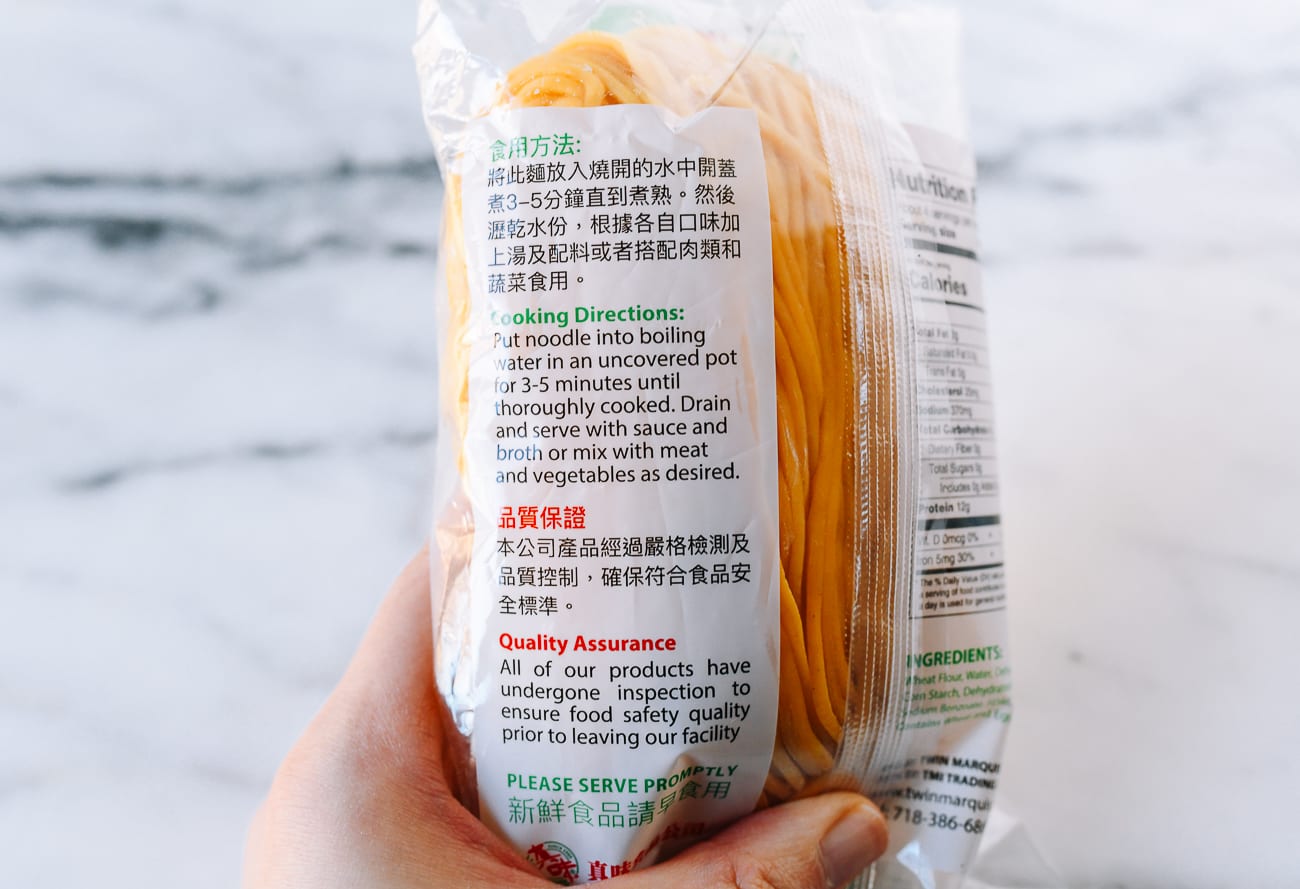
Meanwhile, the cooked version may be labeled simply, “cooked noodle,” “oiled noodle,” or “oil noodle.” They have a shiny appearance, as they are indeed covered in a light coating of oil to prevent them from sticking together.
Cooked lo mein noodles are more convenient and quick than uncooked noodles, as they don’t need to be boiled before stir-frying or adding them to soup. All you need to do is take them out of the refrigerator and let them sit until they come up to room temperature.
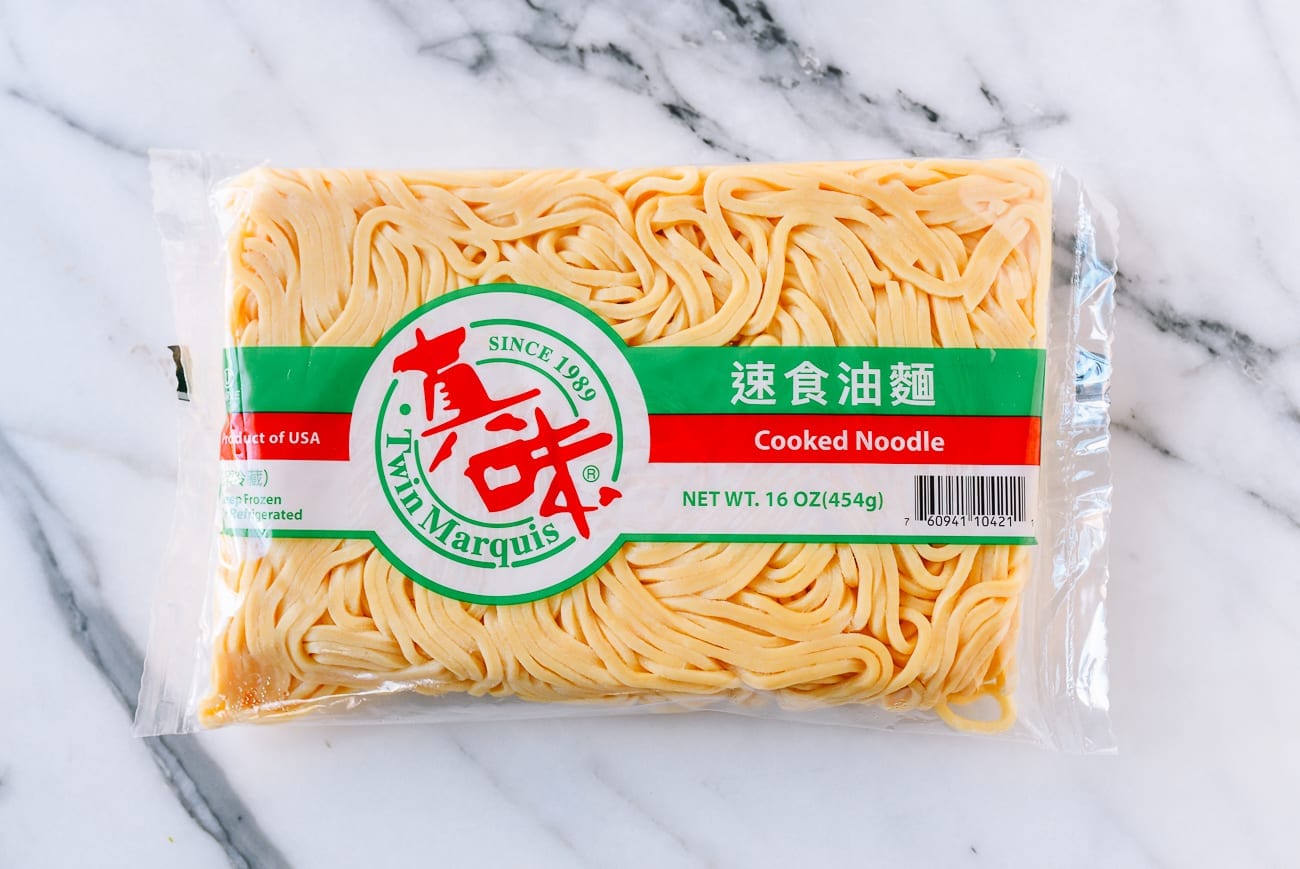
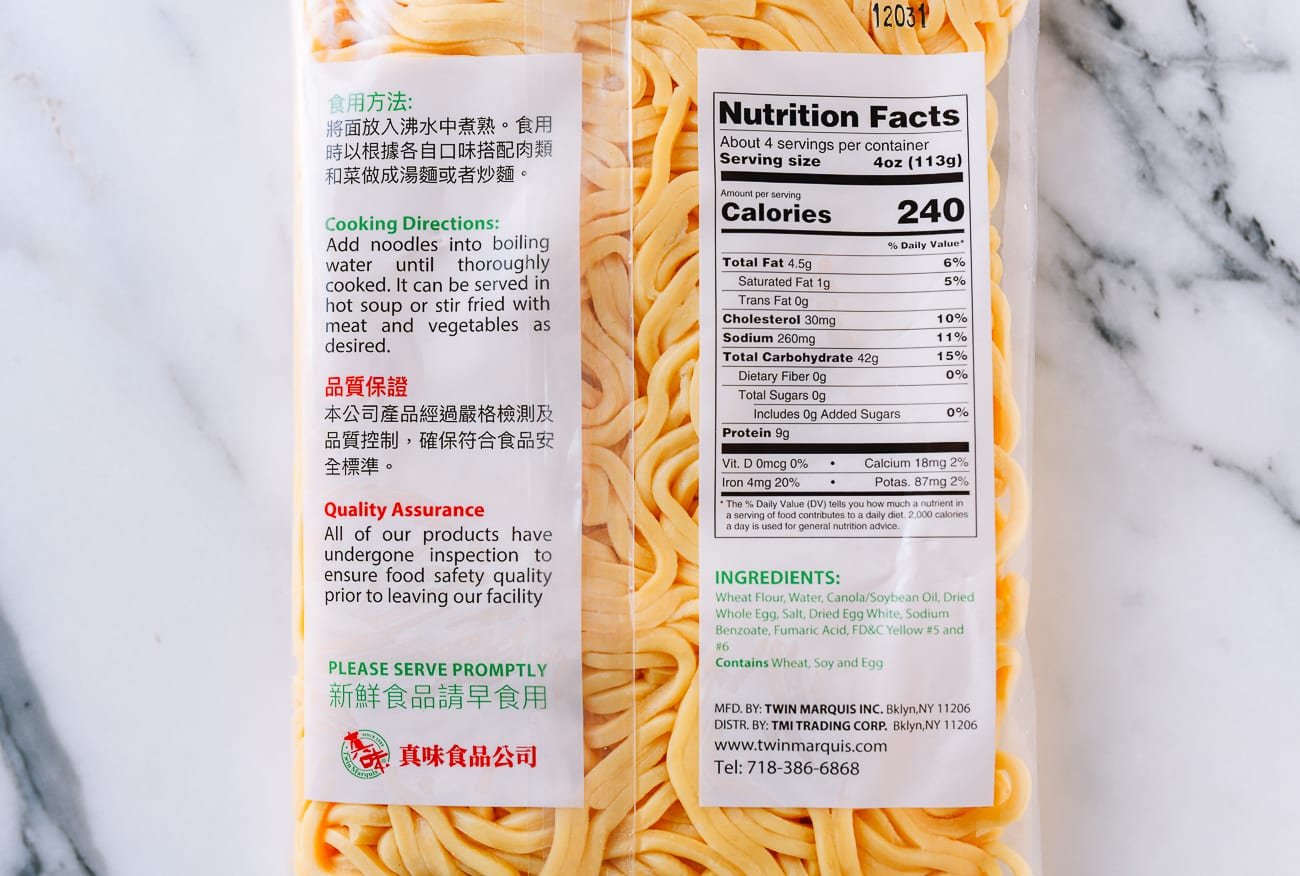
As you can see in the photo above, the package tells you to boil the cooked noodles. This is not necessary, which is why we say that package instructions are a starting point rather than gospel!
We have instructions for both, but it’s important to check the package to see which type you have first.
Note, in addition to stir-frying, you can use these noodles in soups, like Sarah’s Laksa Noodle Soup.
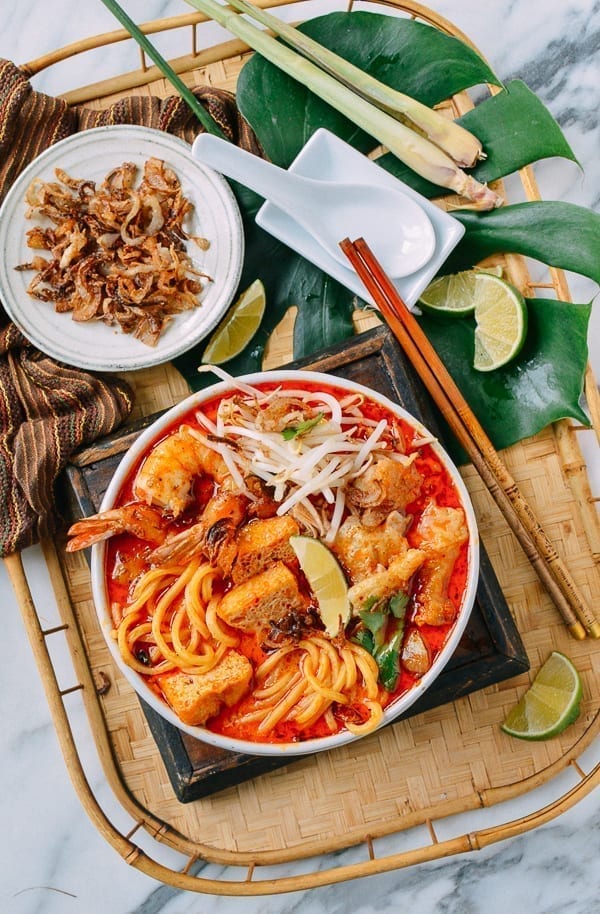
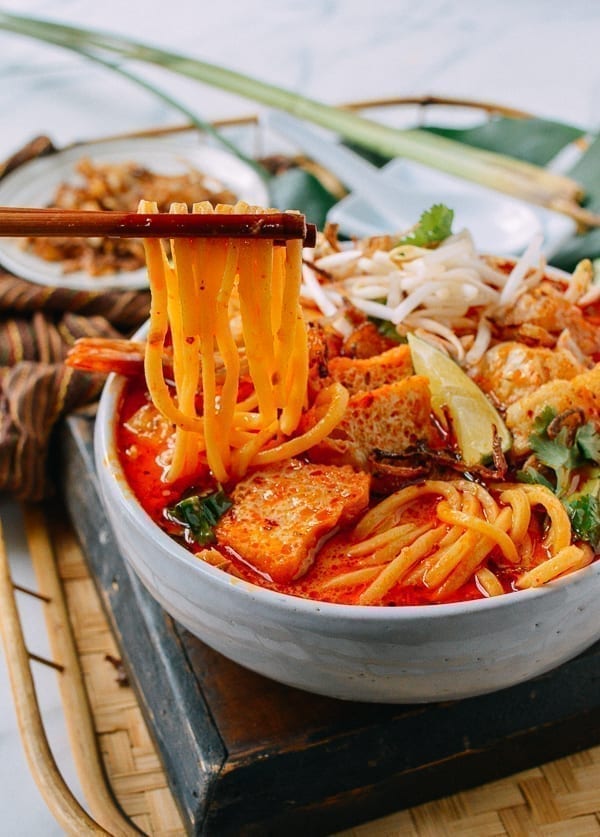
What About Dried Lo Mein Noodles?
You may also see dried white noodles of different thicknesses labeled “lo mein noodles.” While this may indicate that the noodles are suitable for stir-frying after being boiled, we generally don’t use dried noodles to make lo mein.
We find these dried noodles to be closer to regular soup noodles than lo mein noodles. That said, if shelf-stable noodles ordered online are your only option, you can try these. Which brings us to everyone’s favorite topic…substitutions!
Is There a Substitute for Lo Mein Noodles?
Lo mein noodles are usually available in any Chinese or Asian grocery store, in the refrigerated section where all of the fresh noodles, dumpling wrappers, wonton wrappers and egg roll skins are kept. If you don’t have an Asian market near you, however, you may not be able to find them.
If this is the case, you can still have your lo mein! Here are some substitution options:
- Make your own fresh egg noodles: Try our recipe for homemade Chinese egg noodles, which are a snap to make if you have a pasta roller. You can make the noodles somewhat thicker to mimic that lo mein texture, and hand-cut them, or use the cutting blades on your pasta roller. These egg noodles must be boiled, drained, oiled, and cooled slightly before stir-frying.
- Use dried spaghetti or linguine: Boil them, drain, and oil them before stir-frying. This is an ingredient that anyone can get their hands on, making them a convenient substitute.
- Try a dried lo mein noodle: You can try one of the aforementioned dried lo mein noodle brands. Same drill: boil, drain, toss in a neutral oil!
- If you’re looking for a gluten-free alternative to lo mein noodles, your best bet is rice noodles that are suitable for stir-frying, like a pad Thai noodle.
See our Chinese Homemade Egg Noodles below. They are cut pretty thinly, but can be cut thicker for stir-frying:
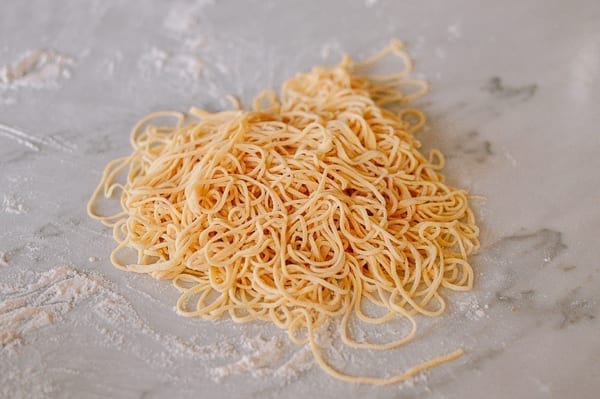
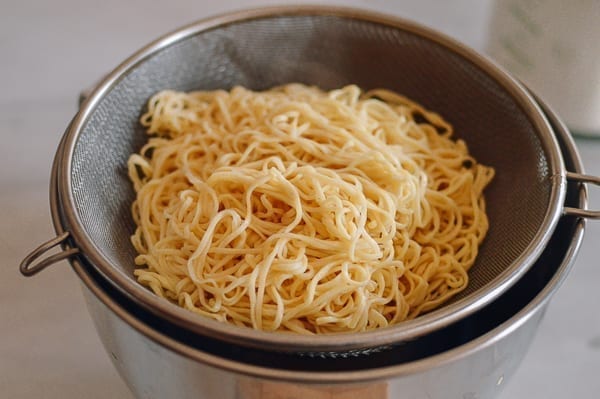
Our Lo Mein Noodle Recipes:
- Chicken Lo Mein: Perhaps the most popular lo mein option. Sarah’s version recreates the lo mein of her childhood.
- Beef Lo Mein: Judy’s all-time favorite, and one of the dishes we made for ourselves most often after a long shift at Sun Hing, my parents’ Chinese restaurant.
- Shrimp Lo Mein: If you’re a shrimp lover, this is the one you go for!
- Roast Pork Lo Mein: Got leftover char siu (Chinese BBQ Pork) in the fridge or freezer? This roast pork lo mein is calling your name!
- Vegetable Lo Mein: A recipe we developed while living in Beijing, packed with colorful veggies and great for a vegetarian meal or side dish.
- Happy Family Lo Mein – a cookbook exclusive! Want everything in your lo mein, from chicken and shrimp to pork and lobster? Make this beloved recipe from our cookbook The Woks of Life: Recipes to Know and Love from a Chinese American Family.
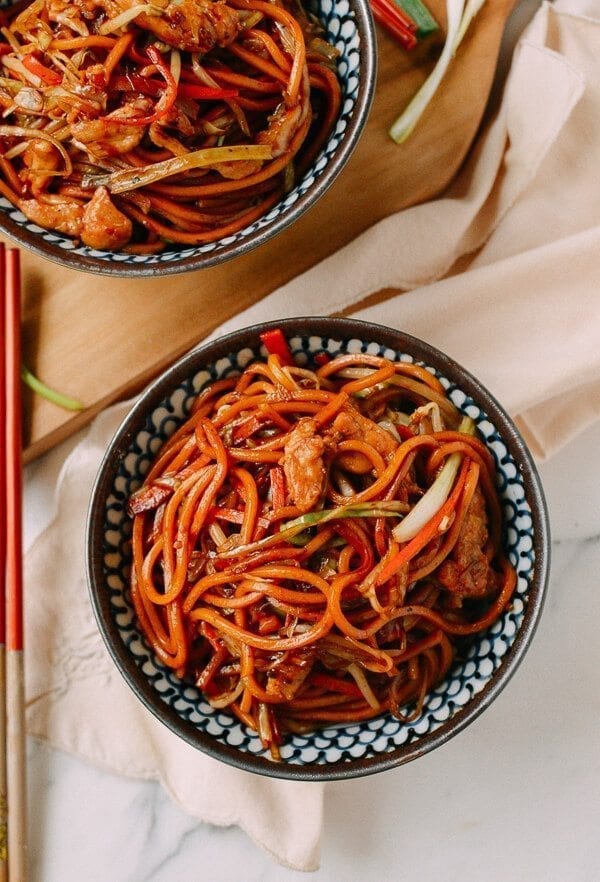
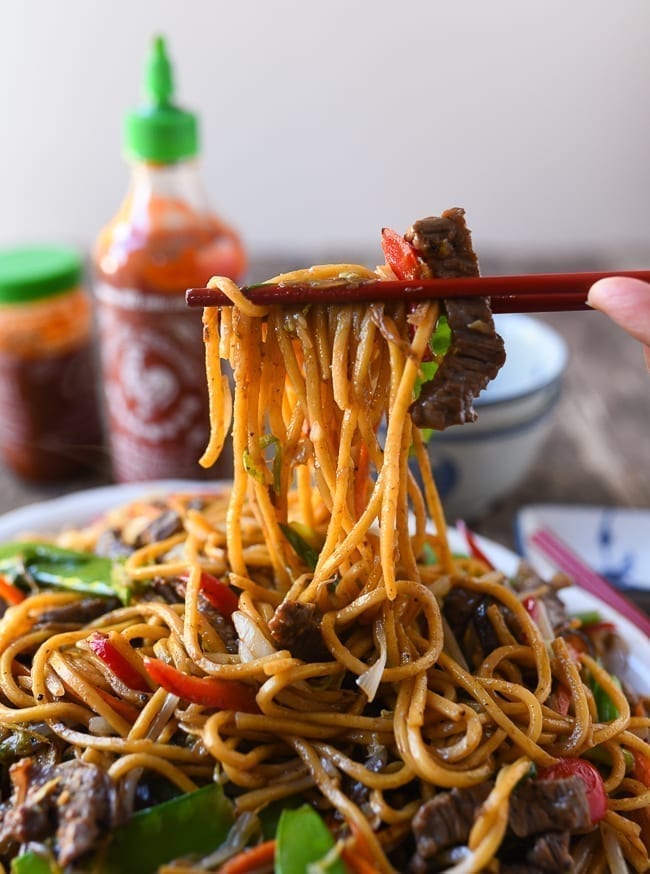
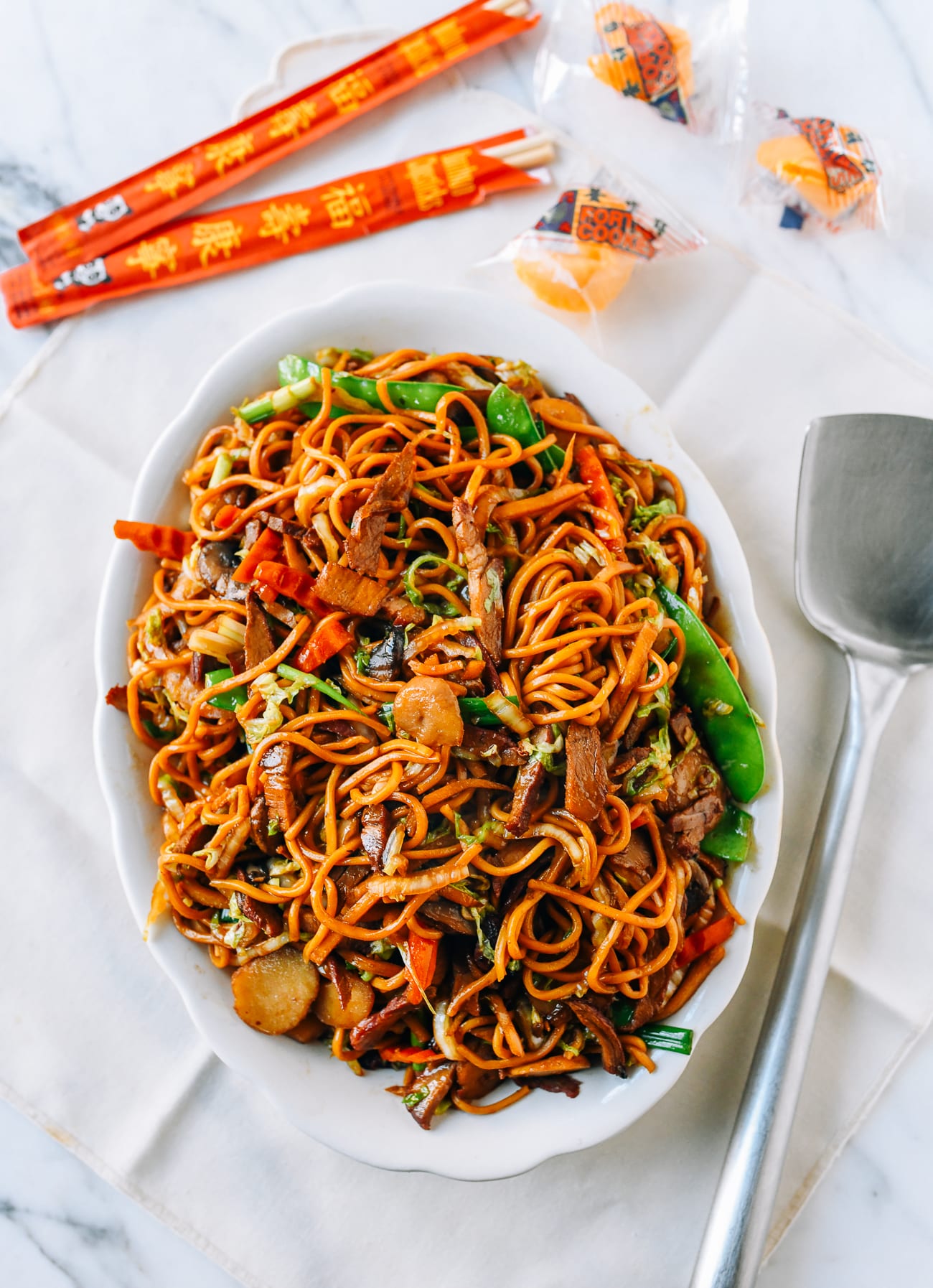
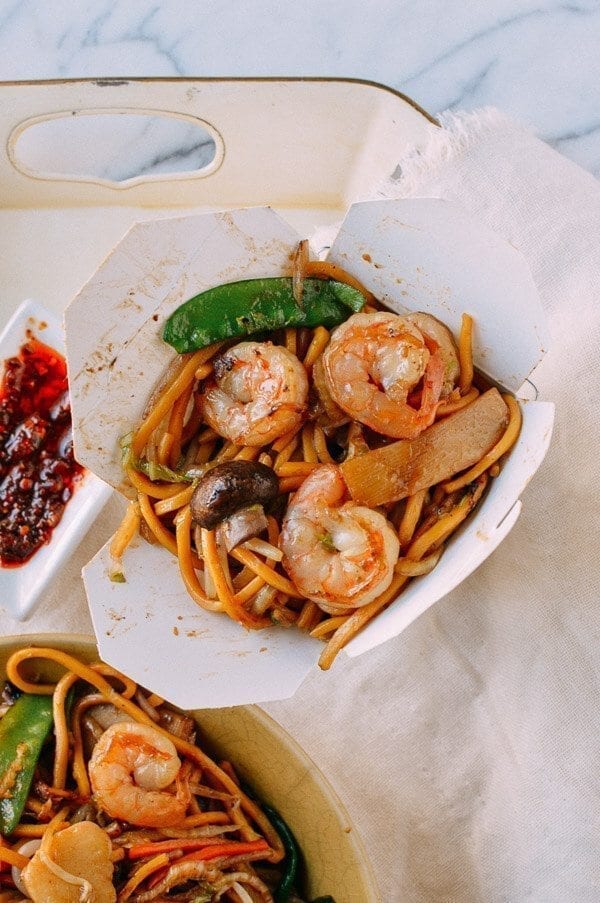
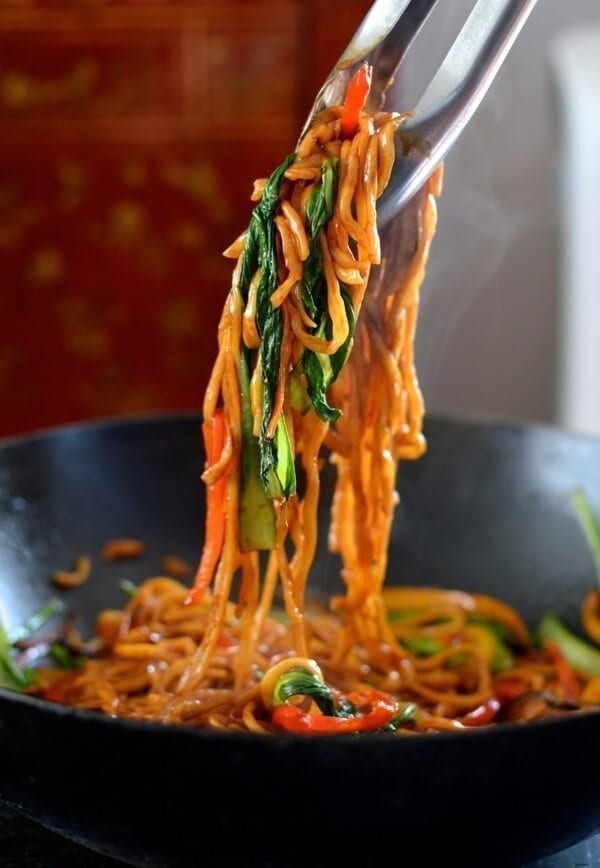
KEY TIPS FOR PREPARING LO MEIN:
Here’s a quick rundown of our most important tips for preparing the noodles:
- Verify whether you have cooked or uncooked lo mein before you start! We’ve all grabbed the wrong package, so just make sure you’re not re-cooking cooked lo mein, or stir-frying raw noodles!
- Packages of lo mein can be frozen for up to 1 month or refrigerated for up to 1 week.
- Read the cooking directions on your uncooked noodles. Manufacturers have different cooking times, and this can be a good starting or reference point for boiling time.
- Cook the noodles right before you are ready to make your lo mein dish, so they don’t dry out. If you have to cook them farther in advance, cover them with a damp towel.
- Don’t walk away from your lo mein while it’s cooking. Things go fast, and you don’t want to overcook the noodles.
- Once done, remove the lo mein from the boiling water right away, and drain. Don’t wait, or the noodles may become overcooked and mushy.
- Rinse your drained noodles under cold water after cooking. This removes any surface starch, preventing sticky noodles.
- After rinsing and boiling, drain the noodles thoroughly, shaking the colander to let out excess water. Then promptly toss the noodles in a neutral oil, to keep them separated.
- If using cooked noodles, make sure they come up to room temperature before using. This keeps the wok hot while stir-frying, and makes them easier to break up. If you’re in a rush, you can dip the noodles into hot water to warm them up quickly. Drain them well before stir-frying.
- The best way of reheating lo mein (after stir-frying) is simply microwaving them!
How to Cook Lo Mein Noodles
First, determine whether you have uncooked or cooked lo mein noodles. If they’re uncooked, bring a large pot of water to a rolling boil, covered. It’s essential to use plenty of water (about 6 quarts should do it), since uncooked noodles will make the water starchy.
Stir in the salt, followed by the raw noodles, and stir with chopsticks to break them up and prevent them from sticking. Cook according to package instructions, tasting the noodles as you go (they may be done earlier), until they’re al dente (cooked through, but not soft—still firm and chewy). Remember, stir-frying the lo mein will cook them further.
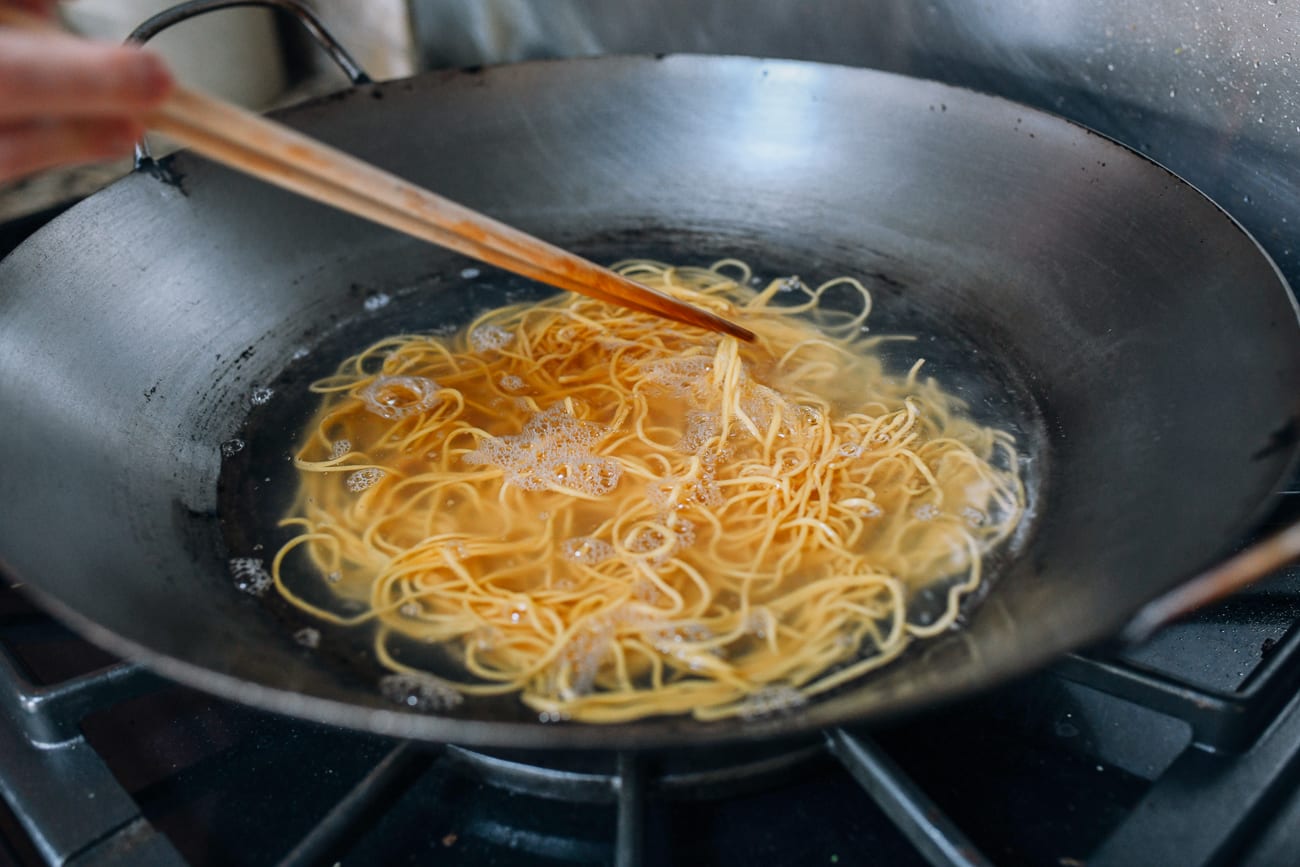
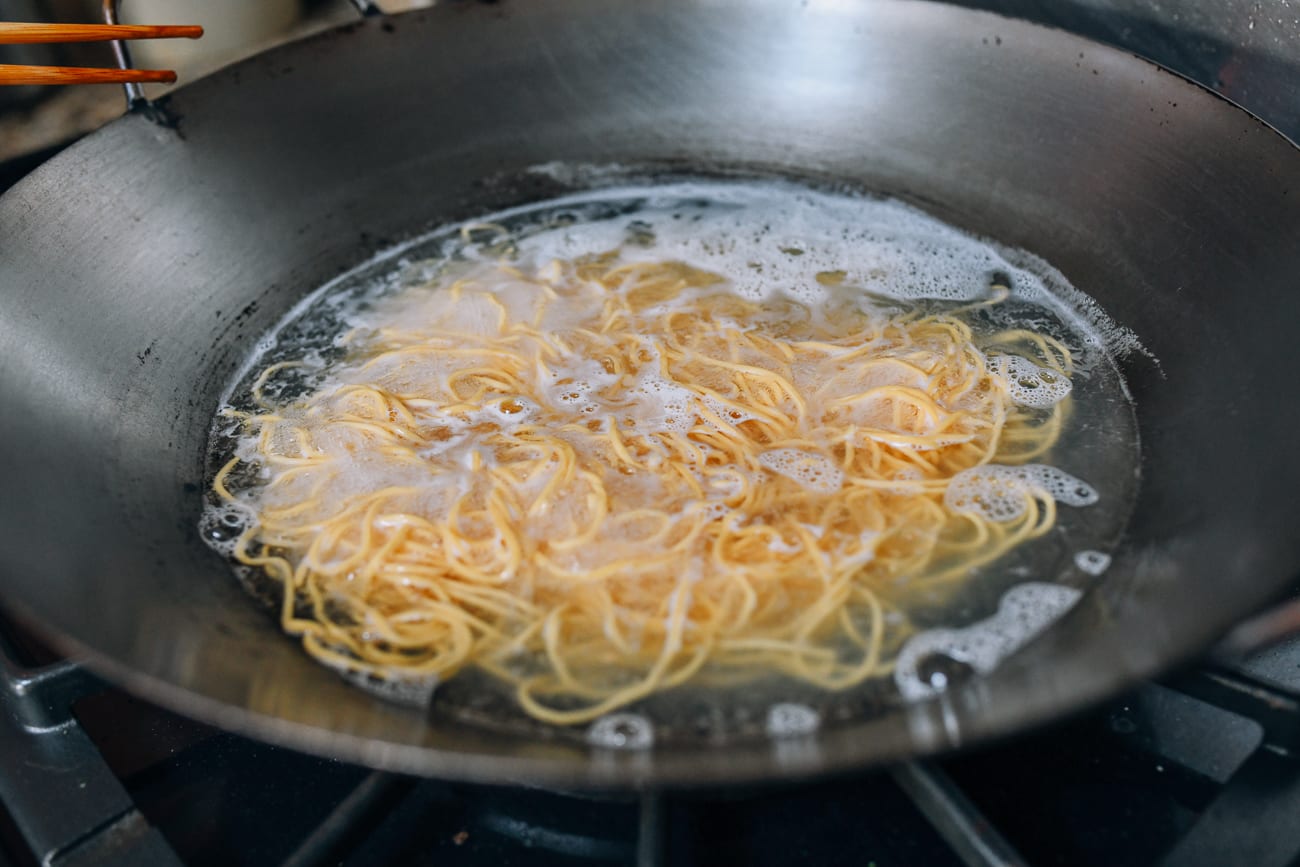
Immediately scoop the noodles into a cold water bath, and let stand for about 30 seconds to stop the cooking process and rinse off surface starch.
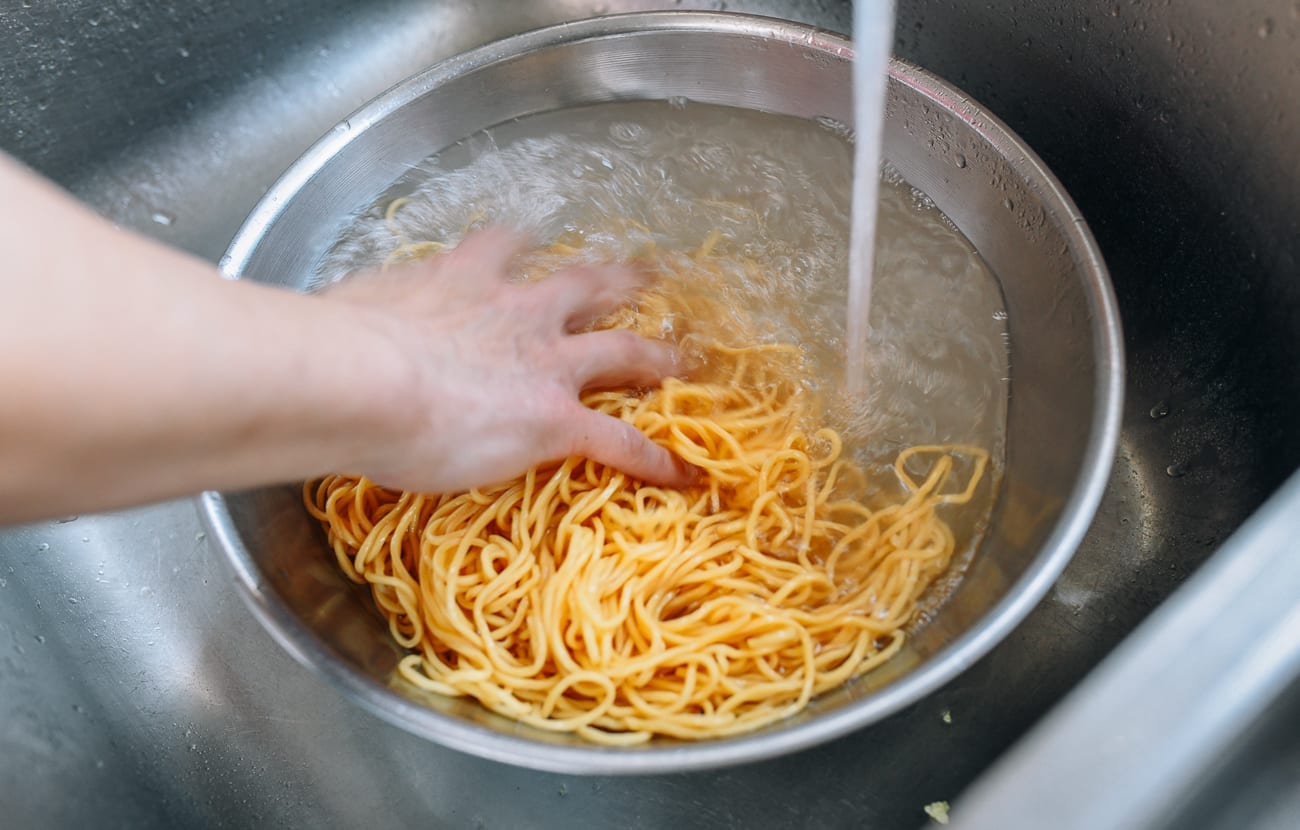
Drain thoroughly in a colander, giving the colander a few good shakes to remove excess water.
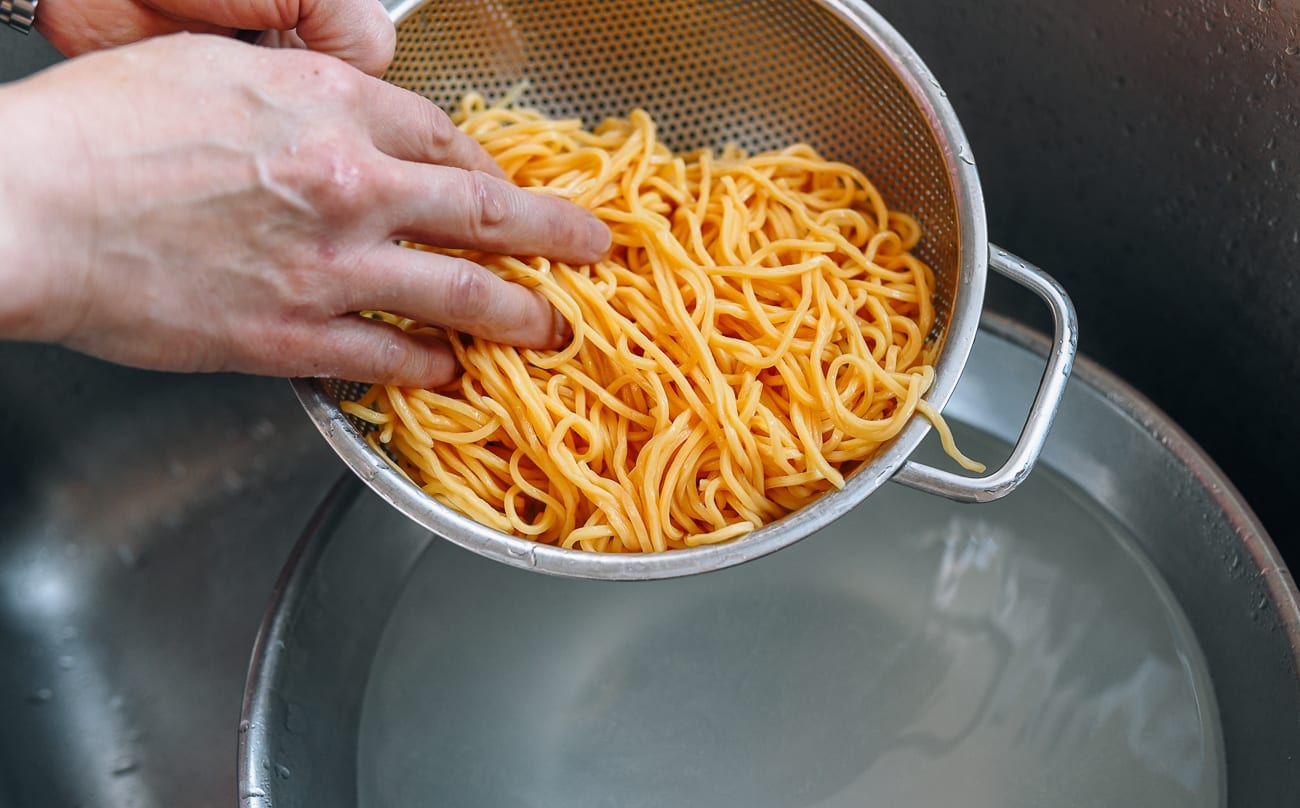
Toss the noodles in the oil, so they’re lightly coated. Your noodles are now ready for the wok! It’s best to stir-fry them within 30 minutes or so of cooking.
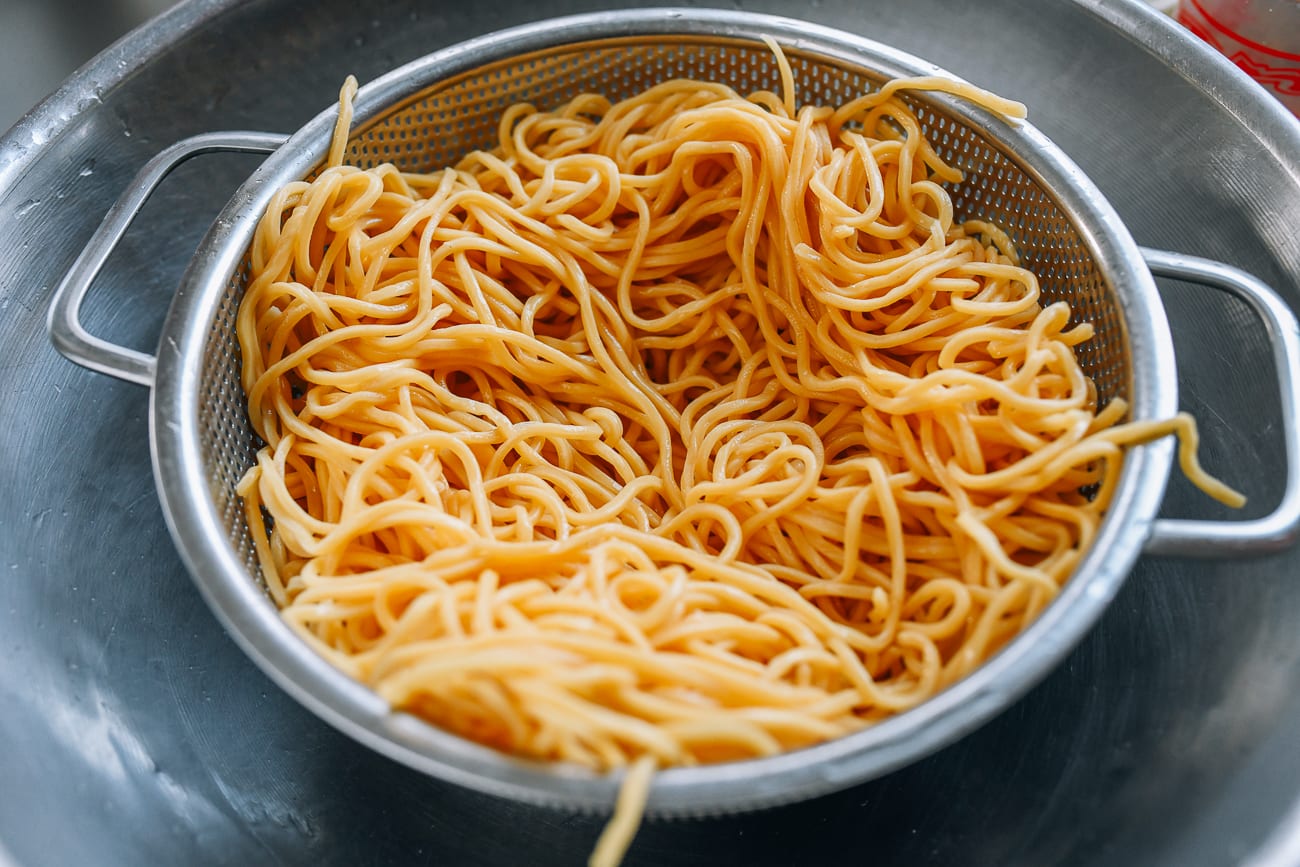
If using cooked lo mein noodles, simply allow them to come up to room temperature. Alternatively, you can put the noodles in a colander and rinse them under hot tap water to warm and loosen them up. Again, drain thoroughly, and coat once again in a couple teaspoons oil before stir-frying.
How to Cook Lo Mein Noodles
Lo mein noodles are one of the most recognizable types of Chinese noodles in the U.S. Here's how to cook lo mein noodles so that they’re perfect—not overly starchy, sticky, soggy, dry, or undercooked.
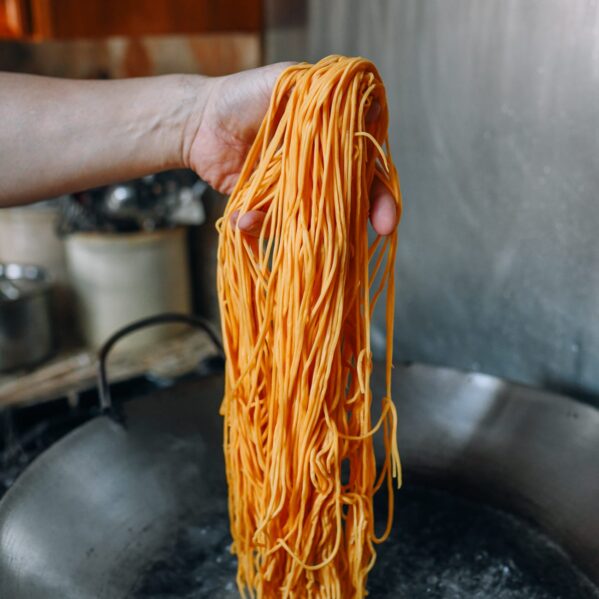
serves: 6
Prep: 10 minutes
Cook: 5 minutes
Total: 15 minutes
Ingredients
Instructions
For uncooked lo mein noodles:
-
Bring a large pot of water to a rolling boil, covered. It’s essential to use plenty of water (about 6 quarts should do it), since uncooked noodles will make the water starchy.
-
Stir in the salt, followed by the raw noodles, and stir with chopsticks to break them up and prevent them from sticking. Cook according to package instructions, tasting the noodles as you go (they may be done earlier), until they’re al dente (cooked through, but not soft—still firm and chewy). Remember, stir-frying the lo mein will cook them further.
-
Immediately scoop the noodles into a cold water bath, and let stand for about 30 seconds to stop the cooking process and rinse off surface starch. Drain thoroughly in a colander, giving the colander a few good shakes to remove excess water.
-
Toss the noodles in the oil, so they’re lightly coated. Your noodles are now ready for the wok! It’s best to stir-fry them within 30 minutes or so of cooking.
For cooked lo mein noodles:
-
Simply allow them to come up to room temperature before stir-frying. Alternatively, you can put the noodles in a colander and rinse them under hot tap water to warm and loosen them up. Drain thoroughly, and coat once again in a couple teaspoons oil before stir-frying.
Tips & Notes:
NOTE: If using dried pasta or dried lo mein noodles, cook according to package instructions until al dente (or 1 minute past al dente if you like your noodles softer—al dente pasta has more bite than al dente lo mein), and scoop them into a cool water bath. Drain thoroughly, coat with oil, and use right away.
nutrition facts
Calories: 268kcal (13%) Carbohydrates: 54g (18%) Protein: 7g (14%) Fat: 3g (5%) Saturated Fat: 0.1g (1%) Polyunsaturated Fat: 0.4g Monounsaturated Fat: 1g Trans Fat: 0.01g Sodium: 617mg (26%) Potassium: 0.1mg Fiber: 1g (4%) Calcium: 0.2mg Iron: 0.003mg







